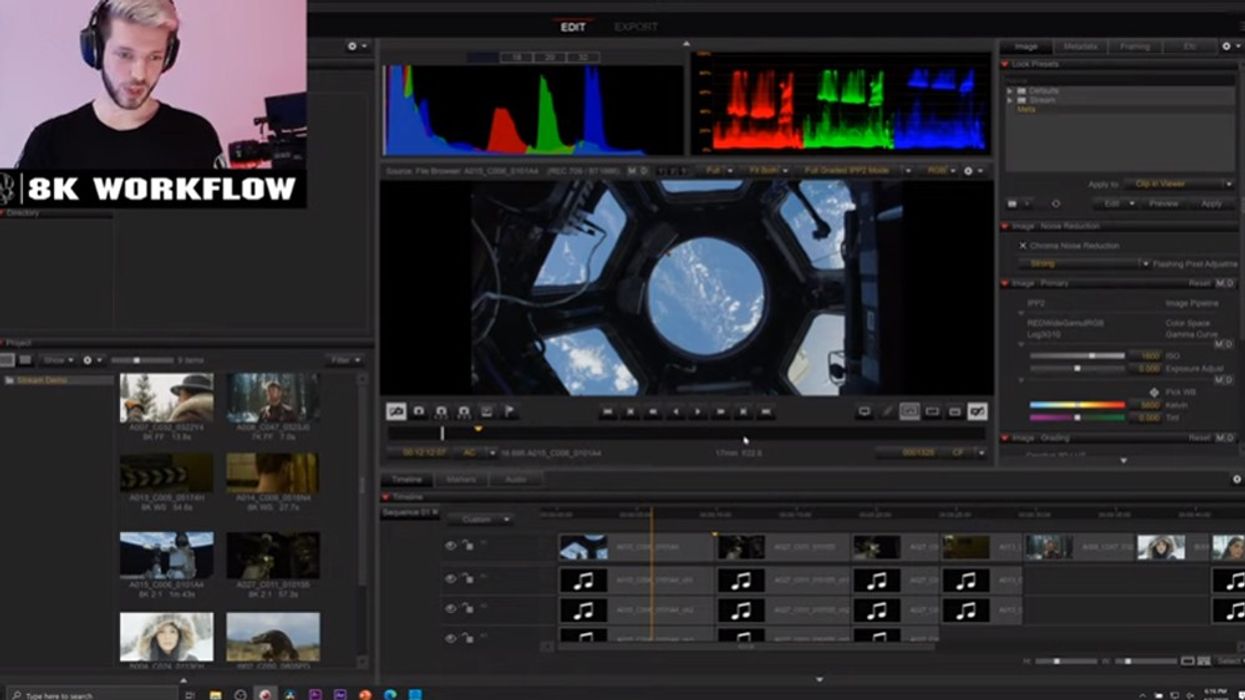What You Can Learn from RED's Free Solitary Series
Here are some highlights from RED's free webinars.

During the first week of April, RED hosted two educational live streaming events that may have flown under the radar. Dubbed the Solitary Series, the free webinars were accessible through Eventbrite, but now have been posted on RED's YouTube channel.
Watch: 8K RAW workflow
Hosted on April 1, RED’s sales engineer Jonathan Petts, focused on REDCODE RAW and tips and tricks using REDCINE-X, which allows you to review and edit R3D files. The hour long seminar has a ton of tricks to learn from, especially those grading RED proprietary files.
1. Playback REDCODE RAW via laptop
When the RED One came out in 2007 it was a little more difficult to playback the 4K RAW files capture by the camera because of limited computer power. All that has changed in recent years and 8K compressed RAW files can now be played back on a laptop with ease. RED has worked closely with Nvidia so that its R3D files play nice with its graphics card in full resolution.
The laptop Petts used was a 15" Razer i7-9750H 6-Core (2.6GHz/4.5GHz) with a RTX 2080 TI graphics card. If you don't want to spend an extra $1,000 on a graphics card, REDCODE RAW files can still be played back using only CPU, but keep in mind the laptop Petts has a 6-core CPU.
During the demo, 8:1 compressed REDCODE RAW files were played back with in 1/8 resolution. Changing the resolution playback on REDCINE-X or any other non-linear editor is helpful if a computer struggles. Doing so can help eliminate the need to generate proxies. However, if the computer struggles even after turning down the resolution, it's best to create a proxy workflow.
2. You can change the ISO or REDCODE RAW files
Metadata can tell you everything about what was shot on the day, and sometimes what's been recorded might be overexposed or underexposed. With REDCODE RAW, you can change the ISO of the recorded file using REDCINE-X. After adjusting the ISO, it can be saved as a non-destructive RMD file to be imported into DaVinci Resolve, and the color grading suite will see the newly adjusted file.
3. Flashing pixels
Flashing pixels are usually painted out by the visual effects team, but REDCINE-X has a cool tool aptly named the Flashing Pixel Adjustment Tool that can automatically remove any flashing pixels of an image in real time.
4. Change to any color space
If you happened to shoot REDCODE as far back as 2007, you can change the color space of those clips to the latest RED color space and gamuts. RED's IPP2 is a big improvement in color science and overhauls the entire image processing pipeline. Though hardware updates make IPP2 possible, all cameras can still benefit from the color pipeline with REDCINE-X.
5. Calculate compression space with this handy tool
REDCODE RAW files can be compressed from 2:1 up to 22:1 depending on the sensor. RED's default compression is 8:1, but even at 22:1, the signal has a better color space than Apple ProRes HQ. We all know compression saves on storage space, but some might be wondering why there isn't an 8K uncompressed RAW option. Well, would you want to shoot uncompressed? A 500GB storage device will only net you about two minutes of shooting time.
On the RED Monstro shooting 8K at 8:1, you get 53 minutes of recording time. RED has created a handy recording time tool that can identity how much storage you may need. 7:1, 8:1, and 9:1 are considered the sweet spots between visually lossless and storage space, but I've found 12:1 as a solid choice, especially if the final deliverable will be YouTube. If VFX is a major part of the shoot, 5:1 might be the preferred choice.
Watch: Why Resolution Matters
While the RED seminar wasn't a debate about why pixel count does or does not matter – cinematographer Steve Yedlin has great demo about resolution the topic that's worth watching – RED's James Lucarelli broke down the number of benefits behind capturing 8K.
Streamed on April 3, around the same time as Blackmagic introduced its ATEM Mini Pro, the video is great for those picking up a RED camera for the first time or for those expanding their skills. It covers stabilization techniques, punching in 4K with 8K, re-framing, among other techniques.
Do you have any tricks using RED cameras or why shoot higher resolution can save a project? Tell us in the comments below.











